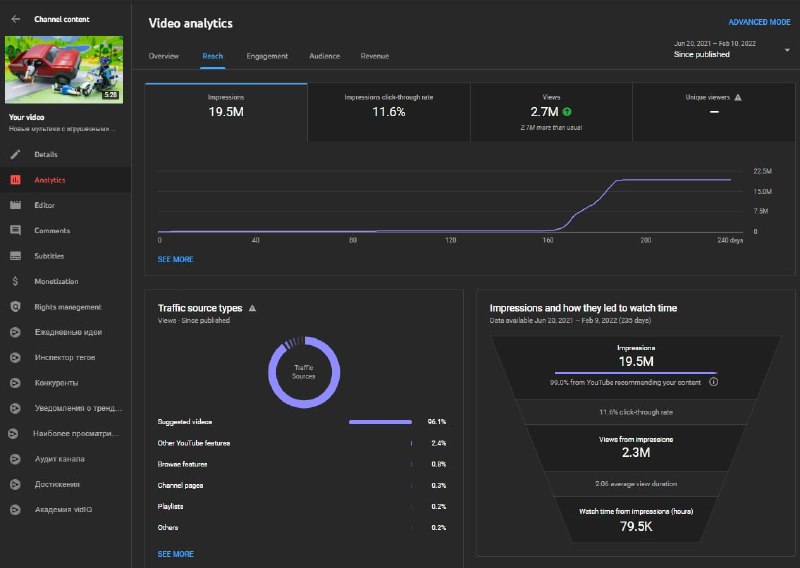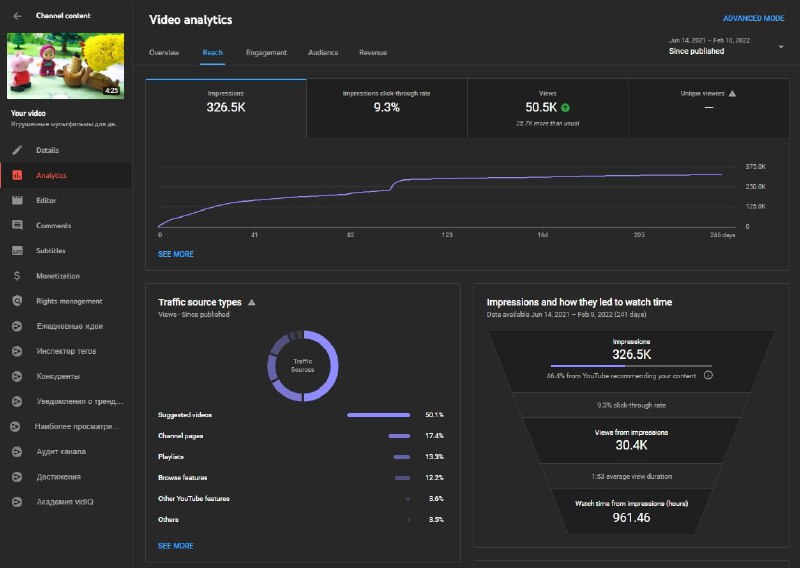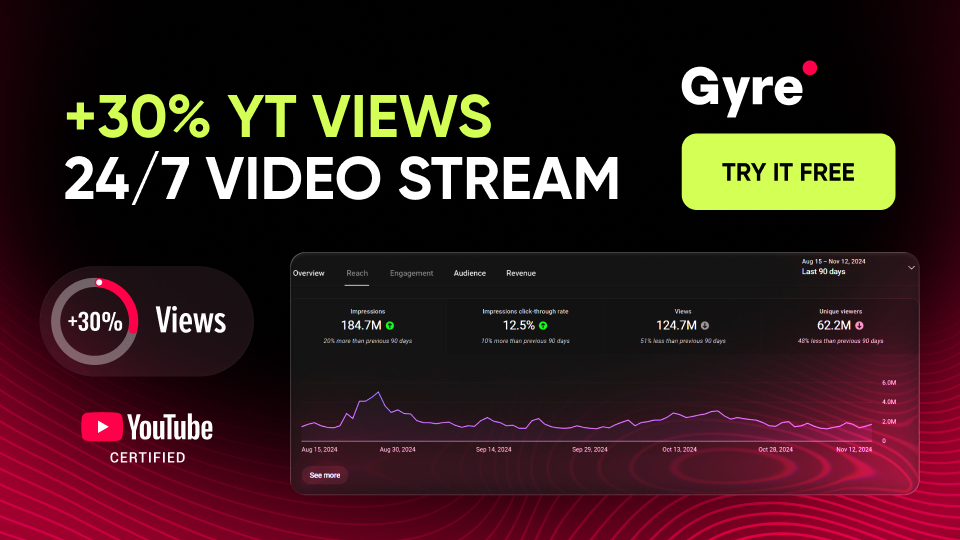Remember the most basic truth: YouTube’s goal is to keep users on the platform for as long as possible. If the video host notices that your video is doing well, it will more likely be seen by new viewers. A high CTR signals to YouTube that viewers are choosing to watch your video, which means it should be featured more often on the home screen, sidebar, or in search results.
The percentage of CTR depends on the clickability of the video thumbnail and title. If women love with their ears, YouTubers love with their eyes. It is extremely important to make the video icon both aesthetically appealing and understandable because this provides the majority of the CTR of the snippet.
The Unwritten Rules of YouTube
Before we start delving into this article’s main topic, we want to offer a few YouTuber rules:
- Do not believe that there are magical instructions with working formulas to gain millions of views.
Don’t waste your time on conspiracy theories. Keep calm and keep creating content.
- For a viewer to watch your video, they must first find it and decide to watch it.
Sounds like Captain Obvious, but this rule is critical to remember because 720,000 hours of video are uploaded to the platform every day on YouTube worldwide (data from Tubefilter, 2019). It would take 82 years to watch these videos uploaded in just 1 day.
With so much video content on the platform, it’s important to make your content stand out, so it breaks through and finds an audience.
- Look at your content through the eyes of a viewer.
Of course, it’s hard to keep an open mind when evaluating your own work. But you are creating a product for an audience, which means you need to consider the logic and criteria for choosing the content for your target audience.
Let’s do a little experiment
Imagine that you want to buy a sweet and juicy watermelon. But what’s the best way to choose a good one? Let’s turn to YouTube for answers.

Here we see the first three results. We deliberately left only the visual component. The decision to watch/not watch takes a few seconds and is often based on the aesthetic appeal of the image to the user.
The first image contains bright contrasting colors and readable, concise text. There’s no visual noise or distracting objects in the background. The author created an organic thumbnail with attractive slices as if hinting that “after watching the video, the viewer will be able to choose the same ripe and appetizing watermelon.” It’s worth noting that the text on the video icon precisely reflects the key query in the search bar. Thus, the author simultaneously completes two tasks: 1) creating a distinctive thumbnail and saving viewers time by helping them quickly “decipher” the video icon; 2) helping the content to be better understood by algorithms and signaling that the content is relevant, useful, and should be recommended to platform users.
The author of the second video used an image with the opposite message. The thumbnail contains advice that it is not worth buying a watermelon with such a tail, and the reason is apparently explained in the video. The video icon creates intrigue and fuels the viewer’s interest, stimulating them to watch the video. The picture itself is effective and informative. There are no distracting details. The absence of unnecessary noise in the photo is not only about aesthetics. There’s a single message for the user which is wise, as the author has only a few seconds to hook the viewer with a thumbnail message about the relevance of the content.
The third video thumbnail is the least helpful. We don’t know the content of this video. Maybe there is relevant and useful content, but the lack of a clear video content message on the thumbnail minimizes the chances of getting views. It’s difficult to predict whether the viewer will receive an answer to their question from this picture. The duration of this particular video also doesn’t help. If the user chooses from a list of recommendations based solely on thumbnails, there’s a possibility that the content of the thumbnail will be misinterpreted. The author will no longer have a chance to convince the viewer that their content is useful.
Now let’s look at these same videos’ titles.

The puzzle has been completed. The titles of the first two videos precisely reflect the user’s key query in the search bar. As for the third video, we understand that it is also relevant thanks to the title. But the first two thumbnails are full-fledged messages for the user, and the last one requires a title.
The experiment results and video thumbnail analysis
CTR is a click-through rate that depends on the thumbnail and title of the video. Before creating video thumbnails for your channel, it’s worth practicing the skill of analyzing existing thumbnails from the audience’s point of view. Analyzing other people’s thumbnails is unbiased and more objective, so we took existing videos on YouTube as an example.
Video thumbnail analysis:
- Scene recognition of the video icon.
By looking at the thumbnail, you can describe a specific message, plot, or key components of the icon including
- Arousing interest or intrigue
- Having a focal point
It can be one or more elements that attract the eye.
What Is The Click-Through Rate (CTR) on YouTube?
CTR is the percentage of video impressions and clicks on the video. For example, if your video was shown 100 times and only 5 users clicked on it, your CTR would be 5%. Once YouTube sees that you are getting thousands of clicks, it will want to recommend your content and expand your target audience.
The higher the number of impressions to the number of clicks, the faster it will rise to the top.
In YouTube Studio, you can see the number of video icon impressions and watch time. Out of 19.5 million impressions, the video received 2.3 million views with a CTR of 11.6% (above average).
Users “read” the message from the video image and made their choice in favor of viewing the content. Again we want to emphasize the importance of the video thumbnail.
The CTR metric itself is at the beginning of the list, which indicates that the metric is important for YouTube algorithms. Impressions are transformed into views and into recommended videos due to CTR.
The more users choose your video from the total impressions, the more valuable your video is to YouTube. And the more active it is promoted, the more often it will be displayed in the top results and recommended.
YouTube click-through rate provides useful information about the performance of the video title, thumbnail, and text description. It is worth adding that the percentage of CTR is also affected by the subject of the video, more precisely, its popularity and relevance. In addition, we do not recommend comparing your CTR and the CTR of other creators’ videos, even in the same niche. In this case, CTR will be affected by many factors, including the target audience, engagement, average viewer retention time, geo, and so on.
Also, CTR is higher in the first hours and days after the publication of the video. After this, it decreases because your content is viewed first by your subscribers and regular viewers. Also, the CTR may differ for different traffic sources (search, recommendations, and YouTube home page).
How to Know Your CTR for YouTube Videos
To find out the video’s click through rate on YouTube, you need to:
- Go to YouTube Studio;
- In the left menu, select the “Analytics” section and then go to the “Reach” tab.
Here, you’ll be able to check the following data:
- Impressions;
- YouTube impression click through rate;
- Number of views;
- Watch time.
It’s important to note that the CTR indicator is displayed as a percentage and shows how many users clicked on your avatar after seeing it.
What Is a Good Click Through Rate on YouTube?
There’s no single answer to the question "What is considered a good click through rate on YouTube?" – it all depends on such aspects as:
- The topic of your content;
- Its target audience and its geography;
- Traffic sources;
- The scale and age of your channel.
For example, there are general estimates for what is a good CTR on YouTube (more than 10%), average (4-6%), and bad (below 2%), but, in practice, everything can be somewhat more complicated. Thus, an average click through rate for YouTube – 8% – for an educational channel will be low for a video from a new channel or an entertainment video that, according to the author's intentions, should go viral. At the same time, a CTR of only 4% may not be a death sentence for a large channel with a million followers, because its wide coverage will play the main role here.
This leads to a very logical conclusion: you shouldn’t compare your CTR with other channels, even in the same niche – it’s much wiser to do this with your own videos to track the dynamics of your channel’s development over time.
How to Increase YouTube СTR
If you don’t want to settle for the average CTR for YouTube videos and wish to maximize the clickability of your videos, use the following recommendations.
Create attractive thumbnails
To make thumbnails look attractive, use contrasting colors and large fonts, but avoid overloading (just choose one visual accent). Also, try to convey emotion or intrigue – both through text and through an image.
Come up with catchy titles
To do this, you have to include keywords and a promise of value for the end viewer in the titles. It’s also important to hold attention through the titles – numbers, intriguing words, as well as their emotional coloring will help you with this. At the same time, you should maintain a balance and don’t mislead your audience – otherwise, it will be perceived as deception, which will ultimately reduce retention.
Analyze traffic sources
Check where your CTR is higher – this can be search, recommendations, or the main page. In fact, you can get valuable insights from here to improve your strategy and, in particular, to subsequently adapt the design of your videos to specific sources.
Implement A/B testing for different thumbnails and titles
YouTube supports built-in A/B testing for thumbnails. It also makes sense to compare similar videos with different titles.
Publish your videos during peak hours
CTR is usually higher in the first hours after publishing, so you’ll need to create a schedule for uploading new videos according to the time zone of your target audience.
Use analytics
Finally, don’t forget to track CTR and engagement. So, if the CTR is below 2%, you should definitely reconsider the title and preview for the causal videos.
The impact of CTR on YouTube video ratings in search results
In our last article, we talked about optimizing existing content with the goal to reindex the videos. The point is to let the YouTube algorithms know that the video is still relevant and useful. Detailed mechanics are described in that article.
In this example, we show how the video icon and title affect the results in the recommended and the number of impressions. We can see a huge difference between two videos on the same channel solely due to a high percentage of CTR.

The first video with a CTR of 11.6% generated 19.5M impressions (99% from YouTube recommending content) and 2.3M views. The second one with a lower CTR of 2.3% gave 59 times fewer impressions – 326.5 thousand (46.4% of the video was shown in the Suggested video).

This is direct evidence of how the thumbnail and the right title promote your video. After all, the viewer doesn’t yet know the content and chooses based only on the visual perception of the thumbnail.
In conclusion, we strongly recommend that you improve CTR – both on existing videos and on new ones.
Increasing the CTR % will provide the channel with more views for the same number of impressions and, in the long run, will help the video get into the recommendations.
Working with a video icon is not as time-consuming and costly as creating high-quality video material. Still, the number of views and getting the audience to watch the material depends on the icon.
Let’s go back to our 11.6% CTR funnel per channel. This is above average, but we want to increase views for the same impressions. We should work on older videos and replace thumbnails on existing videos to do this.
By increasing CTR from 11.6% to 14%, we increase views from 2.3 million to 2.7 million. By increasing the CTR by 2.4%, the channel received 19% (430 thousand) more views. Thus, the channel gains more views by doing just a little work.
The main thing is not only to create new videos but also to optimize existing content. Make it a rule to optimize 5 existing videos per day, and you will notice positive changes in the channel statistics.






